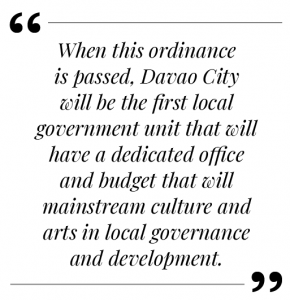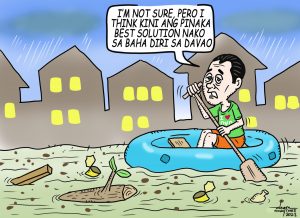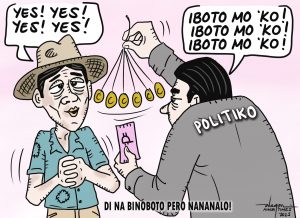 In honor of the 62nd birthday of National Commission for Culture and the Arts (NCCA) Executive Director Oscar “Oca” Casaysay today, I will dedicate my column to talk about a movement he has been leading and organizing since he was a student in the 1980s.
In honor of the 62nd birthday of National Commission for Culture and the Arts (NCCA) Executive Director Oscar “Oca” Casaysay today, I will dedicate my column to talk about a movement he has been leading and organizing since he was a student in the 1980s.
Oca is a theater artist at heart who has been acting in school plays since his elementary and high school days. As a student leader during the turbulent years when Davao was known as the “killing fields,” Oca saw how performing arts can be a powerful tool in spreading social awareness among the youth and getting them to care about their city and country.
Through his college theater group in the University of Mindanao (UM), Oca organized a youth movement of artists and cultural activists who promoted principles of human rights, justice, freedom, and peace. He became so popular in campus that he was pushed to run for student council president.
His love for the performing arts led him to the Philippine Educational Theater Association (PETA), a recipient of the prestigious Ramon Magsaysay Awards, considered as the Nobel Prize for Asia, for “its bold, collective contributions in shaping the theater arts as a force for social change.” His involvement in PETA deepened his understanding of the role of artists in shaping culture and in promoting peace.
Although his college course was in commerce, his passion was in community grassroots organizing so he served in various local and national government and nongovernment organizations doing that throughout his professional career. But whatever his “day job” was then, he always had time for his love for the performing arts.
He later took over as executive director of the famous Kaliwat Performing Arts Collective, a recipient of the prestigious Gador Award, a recognition program for outstanding artists, cultural administrators and organizations in Mindanao initiated by the Kaisa sa Sining (KSS) network of the Cultural Center of the Philippines (CCP).
As leader of Kaliwat, he led a movement of Davao artists and cultural workers to mainstream culture and arts in government development policies and programs. Dubbed “Organizing for Culture and the Arts” or OCA, this was the movement that propelled Oca to run for a seat in the Davao City Council representing the first congressional district in the 2010 elections.
Oca did not win the local elections but he was able to garner an impressive number of votes without any traditional patronage support, financial backing, or even political name recall — just old school grassroots organizing that revolved around a single issue of culture and the arts.
That experience proved that there is a growing local constituency that cares about culture and the arts in Davao City. And it is big enough to be taken seriously.
Because of this, Oca and the movement of artists and cultural workers he led, were asked by Councilor Pilar C. Braga, Chair of the Committee on Education, Culture and the Arts, Science and Technology, to help her draft another landmark ordinance for the City of Davao.
Now on its second reading, the Davao City Office for Culture and the Arts ordinance, will soon become a reality. It is envisioned to be the local counterpart of the NCCA. It will be a new and separate division under the Office of the City Mayor dedicated to culture and the arts.
In other local government units, culture and the arts are integrated into tourism promotions. When this ordinance is passed, Davao City will be the first local government unit that will have a dedicated office and budget that will mainstream culture and arts in local governance and development. Others operate as an advisory council to local chief executives, but this proposed ordinance will create regular positions and budget as part of the structure of the city government.
This office will primarily be responsible for realizing the vision of Davao City to be a “Creative City” — a city that identifies creativity as a strategic factor for sustainable urban development; placing creativity and cultural industries at the heart of its development plans.
The proposed Office will have sections on cultural heritage; cultural communities and traditional arts; cultural dissemination; and the arts (which include architecture and allied arts, cinema, dance, theater arts, literary arts, music, and visual arts).
While waiting for the ordinance to be passed, the Davao Historical Society (DHS), which is also chaired by Councilor Braga, is being assisted by the NCCA in identifying Davao City’s historical landmarks and cultural properties. DHS also partnered with the Institute for Davao Studies (IDS) of the Holy Cross of Davao College (HCDC) to develop educational programs that will build local capacities to promote local history and culture.
But as Oca always reminds his fellow artists and cultural workers, there must be a strong grassroots organizing component. In fact, the proposed ordinance is now close to reality because of the strong lobby of the local artists and cultural workers through the years.
It is a fortunate time to create this Office for Culture and the Arts now under Mayor Sebastian Duterte and Vice-Mayor J Melchor Quitain, Jr. — who are both artists and champions of promoting local culture. Mayor Baste is a musician (he plays drums as part of a local band in his younger years) and a strong advocate of indigenous culture and arts and Vice-Mayor Jay is a visual artist and an alumnus of the Makiling High School for the Arts. And the proponent of the ordinance, Councilor Braga, is also a visual artist who has recently started to exhibit her paintings alongside other local artists.
Oca’s predecessor at the NCCA, Councilor Al Ryan Alejandre, who chairs the Committee on Tourism, is very supportive of the proposed ordinance. His stint at NCCA made him appreciate more the nuances of culture and arts and how it must be distinct from tourism promotions. They may complement, support and enrich each other, but they require different frameworks and skill sets.
The creation of the Office for Culture and the Arts is a good first step in taking the concerns of our artists and cultural workers seriously. But it must be followed by serious investments by the local government. It must include the creation of a city endowment fund that will support local artists and artisans. It must mainstream diversity, inclusion, and peace as part of Davaoeño culture.
With Oca now at NCCA, Davaoeño artists are more inspired to grow and strengthen our local movement for culture and the arts to make Davao a truly creative city.


